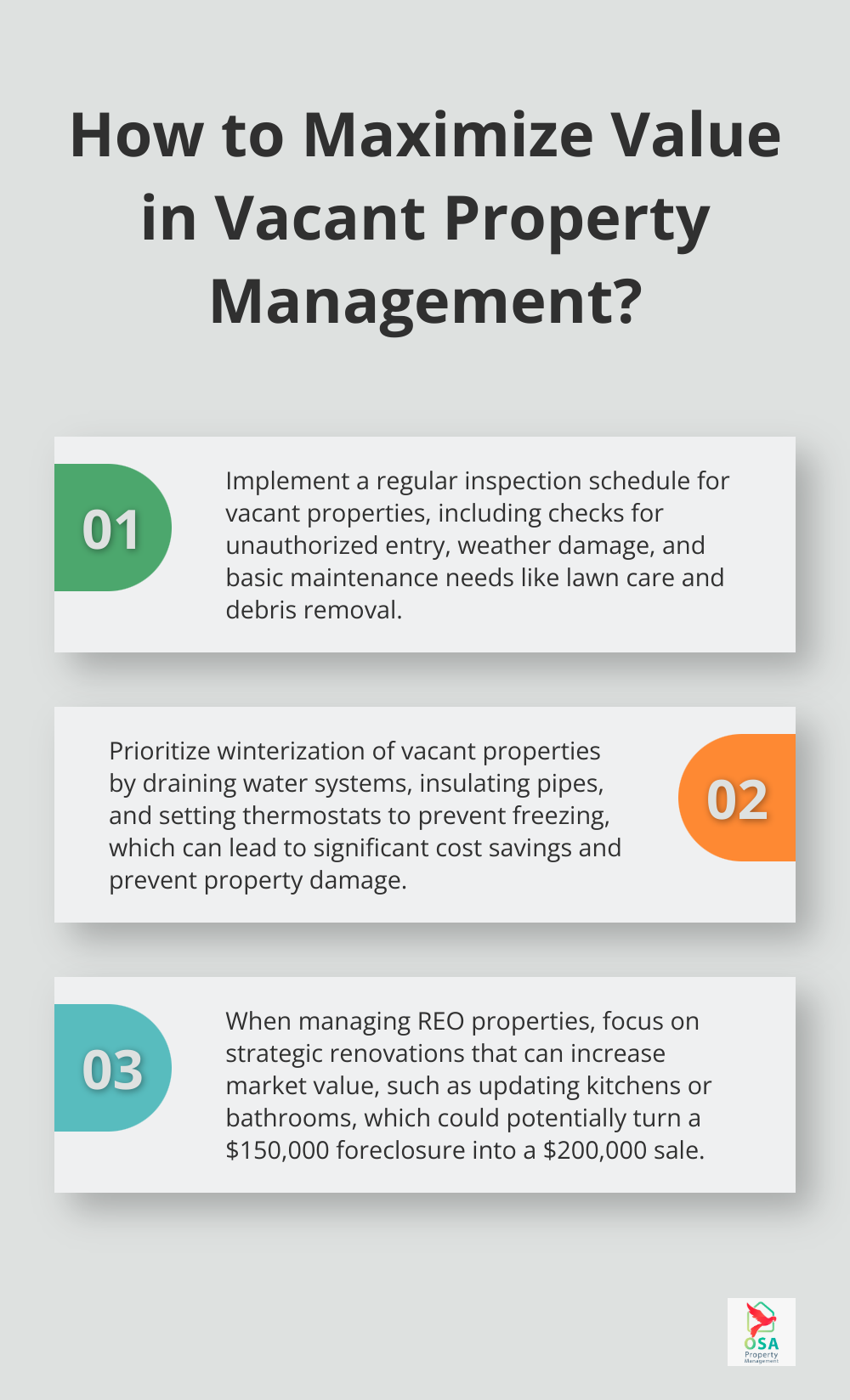At Osa Property Management, we often encounter confusion about the roles of property preservation and REO services in the real estate industry. These two distinct services play crucial roles in maintaining property value, but they operate at different stages of the foreclosure process.
In this blog post, we’ll explore what is the difference between property preservation and REO services, helping you understand their unique purposes and responsibilities.
What is Property Preservation?
Definition and Purpose
Property preservation is a vital service in the real estate industry, particularly for vacant or foreclosed properties. It involves the maintenance and protection of properties to prevent deterioration and ensure compliance with local regulations. At Osa Property Management, we understand the importance of this service in maintaining property values and community standards.
Key Activities
Property preservation encompasses a wide range of activities:
- Regular inspections
- Securing properties against unauthorized entry
- Winterization to prevent damage from freezing temperatures
- Basic maintenance tasks (lawn care, debris removal)

For instance, a property preservation team might change locks, board up windows, repair minor damages, and manage pest control to keep a vacant property in good condition.
Impact on Property Values
The significance of property preservation extends beyond individual properties. It plays a key role in maintaining property values in neighborhoods affected by foreclosures. Poor maintenance of foreclosed properties can negatively affect communities and threaten neighborhood stability.
Financial Considerations
Property preservation can lead to substantial cost savings. This is particularly true when considering the main drivers of the cost of abandoned properties and the potential to mitigate some of this harm.
Property preservation represents a proactive approach to property management. It protects assets, maintains community standards, and ultimately saves money for all parties involved in the real estate ecosystem. As we move forward, it’s important to understand how this service differs from REO services, which we’ll explore in the next section.
What Are REO Services?
Definition of REO Properties
Real Estate Owned (REO) properties are assets that lenders (typically banks) repossess after unsuccessful foreclosure auctions. These properties represent a unique segment of the real estate market, often requiring specialized management and sales strategies.
The REO Process
When a property becomes REO, it enters a distinct phase of the foreclosure process. Banks want to sell these properties quickly to recoup their losses. This necessity creates a specific niche in the real estate industry for REO services.
Core REO Services
REO service providers handle a wide range of tasks. These include:
- Property valuation
- Marketing
- Coordinating repairs
For example, an REO service might oversee renovations to increase a property’s market value (potentially turning a $150,000 foreclosure into a $200,000 sale).
Challenges in REO Management
Managing REO properties comes with unique challenges. One major issue is the condition of these properties. According to recent housing market indicators, overall activity in housing markets improved as of February 2024. REO service providers work to minimize challenges through strategic improvements and effective marketing.
Legal and Financial Aspects
REO services also navigate complex legal and financial terrains. This includes:
- Ensuring compliance with local regulations
- Managing property taxes
- Handling title issues
A recent study found that a quarter of Auction.com sales were sold to owner-occupants, with a higher share of foreclosure sales (30.1 percent) than REO sales (20.5 percent). This emphasizes the need for expert management during the sales process.

While property preservation focuses on maintaining vacant properties, REO services take a more comprehensive approach to preparing and selling bank-owned properties. This distinction becomes clearer when we examine the key differences between these two services in the next section.
How Property Preservation and REO Services Differ
Property preservation and REO services serve distinct purposes at different stages of the foreclosure process. Understanding these differences is key for property owners and investors.
Timing in the Foreclosure Process
Property preservation starts when a property enters the pre-foreclosure stage or becomes vacant. This service continues throughout the foreclosure process to maintain the property’s condition. REO services begin after the foreclosure auction, when the lender repossesses the property.

The National Association of Realtors reports that the average foreclosure process takes about 922 days (2.5 years). Property preservation services maintain the asset’s value during this period. REO services focus on the post-foreclosure period, which can last from a few months to over a year, depending on market conditions.
Scope of Responsibilities
Property preservation primarily maintains and secures the property. This includes regular inspections, lawn care, winterization, and protection against vandalism or unauthorized entry. The goal is to prevent deterioration and comply with local regulations.
REO services manage the entire process of preparing a bank-owned property for sale. This involves maintenance, renovations, marketing, and facilitating the sale process. REO service providers often improve the property’s marketability, which can involve significant renovations or upgrades.
Stakeholders and Client Base
Property preservation services typically work with mortgage servicers, banks, or property management companies. Their primary goal is to protect the lender’s interests by maintaining the property’s condition and value.
REO services interact with a more diverse set of stakeholders, including banks, real estate agents, potential buyers, and various contractors. Their client base often includes institutional investors and banks looking to sell foreclosed properties quickly and efficiently.
Legal and Regulatory Landscape
Both services operate under strict legal and regulatory frameworks, but with different focuses. Property preservation must adhere to local ordinances regarding property maintenance and occupancy. They must address issues like squatter’s rights and ensure compliance with HUD guidelines for preserving foreclosed properties.
REO services face additional legal complexities. They must manage title issues, ensure proper disclosures during the sale process, and comply with various state and federal regulations governing the sale of bank-owned properties. The Consumer Financial Protection Bureau mandates specific disclosure requirements for REO properties, which REO service providers must carefully manage.
Final Thoughts
Property preservation and REO services fulfill different roles in real estate management. Property preservation maintains vacant or foreclosed properties to prevent deterioration, while REO services prepare bank-owned properties for sale after foreclosure. Understanding what is the difference between property preservation and REO services helps property owners and real estate professionals make informed decisions.

These services operate at different stages of the foreclosure process and involve distinct responsibilities and stakeholders. Property preservation starts earlier, focusing on maintenance and security, whereas REO services manage the entire process of preparing and selling foreclosed properties. Both services protect investments and maintain property values, but they approach these goals through different methods and timelines.
At Osa Property Management, we offer expert property management services in Costa Rica (including areas like Tarcoles, Jaco, and Uvita). Our team’s expertise in marketing, maintenance oversight, and renter relationships can provide valuable support for property owners navigating complex real estate processes. We encourage property owners and investors to stay informed about these specialized services to effectively manage their real estate assets.

